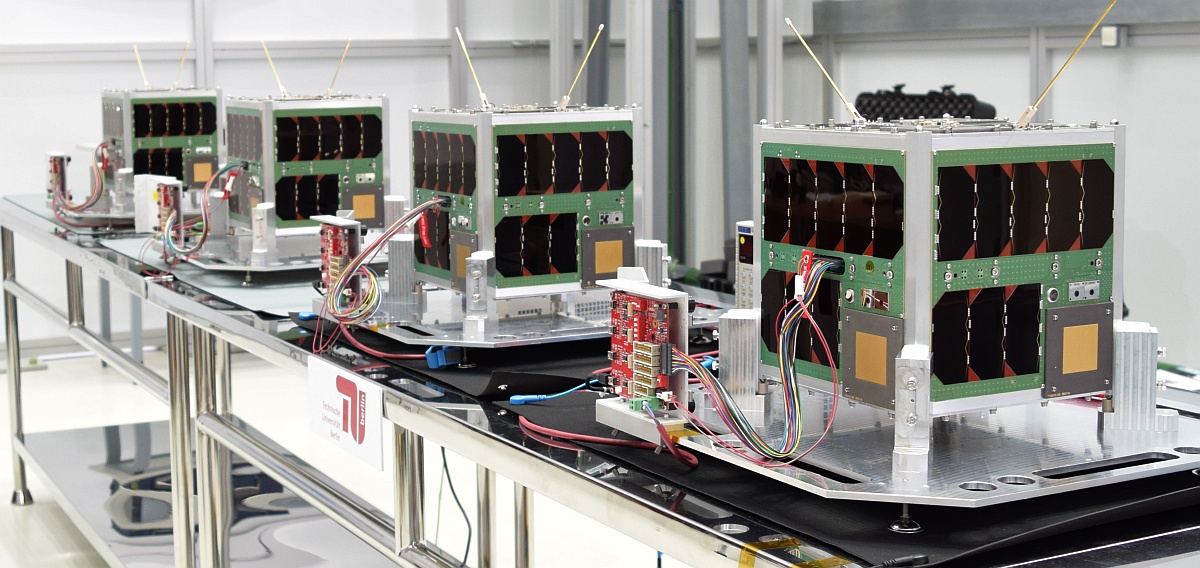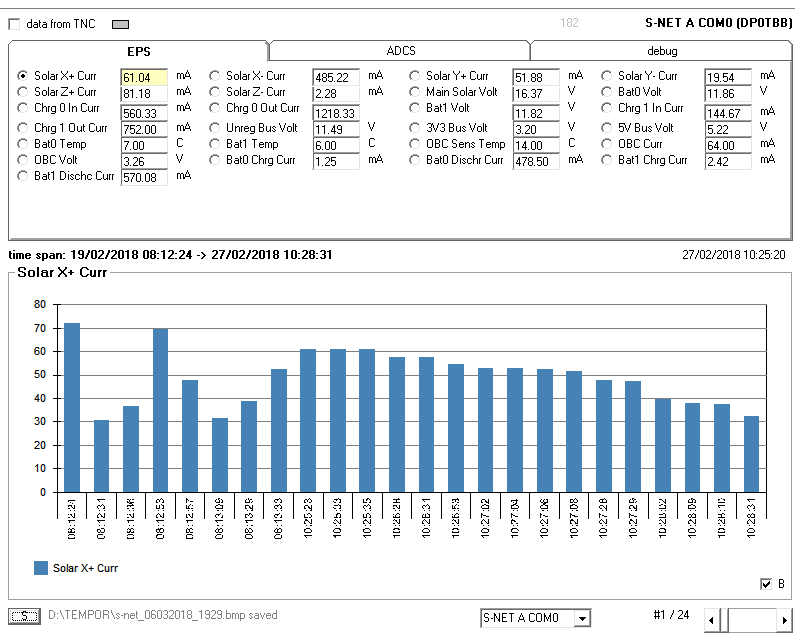| Satellite | Status | NORAD | Uplink | Downlink | Beacon | Mode | Callsign | Reports | Info | IARU freq coord | Telemetry Decoder |
|---|---|---|---|---|---|---|---|---|---|---|---|
| S-NET A S-NET B S-NET C S-NET D |
ACTIVE | 43186 – 43189 | 435.950 | 1k2 FFSK | DP0TBB DP0TBC DP0TBD DP0TBE |
latest report | details | YES |  |
Networks of autonomous satellites that can communicate with each other: this is how the future of space travel should look and how it can be used in key areas such as communication, Earth observation, and the exploration of distant planets. With the “S-NET” mission, a world-wide unique flying association consisting of four micro-satellites will test new technologies for this purpose in space and prove their functionality. On February 1, 2018, at 3:07 pm Central European Time (CET), a Russian Soyuz-2-1a Fregat-M launcher launched from the Vostochny Space Station has launched the quartet into low earth orbit orbit. The technology mission of the TU Berlin is funded by the German Aerospace Center (DLR).
Downlink: 435.950 MHz, 1k2 FFSK

A space network of nanosatellites can achieve a higher local and temporal coverage of the earth’s surface through the targeted exchange of information among themselves than larger individual satellites. In addition, the possible failure of a single satellite within an autonomous network can be better compensated.

It is also possible to transmit data and signals much faster to the receiving stations on earth: In the previously customary satellite communication in low Earth orbit, resulting raw data are sent to a ground flight over ground stations with a delay of several hours to Earth, processed, archived and distributed. The delivery of data products usually takes one to several days. The new satellite constellations will make this possible in one to two hours. Especially in the prediction of natural disasters and in the emergency response would be a time gain through immediate processing in orbit and the communication from satellite to satellite to the nearest ground station a big win.
Amateur Radio Payload (will be activated later)
A selected S-Net satellite transmits a specific data packet at a fixed period (e.g., several times per minute) and over a particular area.
* the packet contains an sequence (140 bytes) in ASCII plain text (without encoding). Currently it says something like: “Hello World! This is S-NET: the intersatellite communication network of TU Berlin and DLR, vist also www.bit.ly/S-NET”)
* the transmitted byte sequence can be freely changed in advance in the memory of the satellite by the S-Net team
Every radio amateur can send his message to the S-Net team, together with the desire, when, over which area and how often it should be sent.
RF Spectrum – all four satellites active

Telemetry
Frame Structure

assignment SrcID to call sign
0 = SNET-A / COM0 -> DPOTBB 1 = SNET-A / COM1 -> DPOTBB 2 = SNET-B / COM0 -> DPOTBC 3 = SNET-B / COM1 -> DPOTBC 4 = SNET-C / COM0 -> DPOTBD 5 = SNET-C / COM1 -> DPOTBD 6 = SNET-D / COM0 -> DPOTBE 7 = SNET-D / COM1 -> DPOTBE
EPS telemetry packet
1: [S-NET] [12:35:57R] [SrcId:0 DstId:127 FrCntTx:0 FrCntRx:0 SNR:15 AiTypeSrc:1 AiTypeDst:3 DfcId:0 Caller:0 Arq:0 PduTypeId:0 BchRq:0 Hailing:0 UdFl1:0 PduLength:62] F3 50 34 E0 C0 01 20 36 9F 96 09 00 00 92 22 00 90 80 21 00 00 01 47 00 48 00 14 00 01 05 03 01 08 00 00 00 00 00 00 18 00 00 67 6A A6 2A 0A 07 08 04 04 10 00 00 07 01 00 00 00 00 D1 D3 1: [S-NET] [12:36:01R] [SrcId:0 DstId:127 FrCntTx:0 FrCntRx:0 SNR:15 AiTypeSrc:1 AiTypeDst:3 DfcId:0 Caller:0 Arq:0 PduTypeId:0 BchRq:0 Hailing:0 UdFl1:0 PduLength:62] F3 50 2B A0 C0 01 20 36 7B 9C 09 00 00 92 22 00 90 80 21 00 00 01 47 00 48 00 14 00 01 05 03 01 1E 00 00 00 00 00 00 18 00 00 69 68 A8 2A 0A 05 08 02 04 10 00 00 07 01 00 00 00 00 67 D4
SrcID = 0 -> 0 = SNET-A / COM0 -> DPOTBB
| HDR parameter | Value | HDR parameter | Value |
|---|---|---|---|
| Server time | 2018-02-21 08:30:23.000000 UTC | Type | TM |
| FRSYNC | 249152 | Urgent | NO |
| CRC | 15896 | RFU | NO |
| FCID_MAJ | FCIDM_EPS_HK_TELEMETRY | CRC active | YES |
| FCID_SUB | EPS_STD_TM | Multiframe | NO |
| Data length | 50 | TT setting | YES |
| Time tag | 2018-02-21 08:30:23.000000 UTC | TT active | YES |
| Parameter | Description | Value | Unit | Parameter | Description | Value | Unit |
|---|---|---|---|---|---|---|---|
| EPS_PGET_S00_CUR_SOLX_POS | current X+ solar panel | 15.56 | mA | EPS_PGET_S01_CUR_SOLX_NEG | current X- solar panel | 17.08 | mA |
| EPS_PGET_S02_CUR_SOLY_POS | current Y+ solar panel | 0.3 | mA | EPS_PGET_S03_CUR_SOLY_NEG | current Y- solar panel | 192.72 | mA |
| EPS_PGET_S04_CUR_SOLZ_POS | current Z+ solar panel | 3.06 | mA | EPS_PGET_S05_CUR_SOLZ_NEG | current Z- solar panel | 482.18 | mA |
| EPS_PGET_S06_V_SOL | main solar voltage (2,42V = 25V) | 16520 | mV | EPS_PGET_S24_V_BAT0 | voltage battery 0 (2.37V@12.6V) | 12256 | mV |
| EPS_PGET_S26_A_IN_CHARGER0 | input current charger0 (2.5V@2500mA) | 378.417 | mA | EPS_PGET_S25_A_OUT_CHARGER0 | output current0 (2.5V@5000mA) | 212.333 | mA |
| EPS_PGET_S13_V_BAT1 | voltage battery 1 (2.37V@12.6V) | 12291.5 | mV | EPS_PGET_S23_A_IN_CHARGER1 | input current charger1 (2.5V@2500mA) | 326.5 | mA |
| EPS_PGET_S14_A_OUT_CHARGER1 | output current charger1 (2.5V@5000mA) | 170.833 | mA | EPS_PGET_S22_V_SUM | sum voltage unregulated bus (2.39V = 14V) | 12052.5 | mV |
| EPS_PGET_S44_V_3V3 | voltage 3V3 bus (2.4V@3.6V) | 3166.75 | mV | EPS_PGET_S45_V_5V | voltage 5V bus (2.39V@5.5V) | 5180 | mV |
| THM_PGET_S31_TH_BAT0 | temperature of battery 0 | 8 | °C | THM_PGET_S15_TH_BAT1 | temperature of battery 1 | 9 | °C |
| THM_PGET_TH_OBC | temperature OBC external sensor (LMT85) | 16 | °C | EPS_PGET_A_OBC | current of OBC (2V@400mA) | 55 | mA |
| EPS_PGET_V_OBC | voltage of OBC (2.048V@4.096V) | 3257 | mV | EPS_PGET_S30_A_IN_BAT0 | charge current battery 0 (2.5V@2500mA) | 244.167 | mA |
| EPS_PGET_S29_A_OUT_BAT0 | discharge current battery 0 (2.5V@2500mA) | 3.08333 | mA | EPS_PGET_S12_A_IN_BAT1 | charge current battery 1 (2.5V@5A) | 245.333 | mA |
| EPS_PGET_S20_A_OUT_BAT1 | discharge current battery 1 (2.5V@2500mA) | 4.25 | mA |

RF spectrum

great thanks to Andy, UZ7HO for his continuous and competent work
1: [S-NET] [23:36:04R]
[SrcId:0 DstId:127 FrCntTx:0 FrCntRx:0 SNR:15 AiTypeSrc:1 AiTypeDst:3 DfcId:0 Caller:0 Arq:0 PduTypeId:0 BchRq:0 Hailing:0 UdFl1:0 PduLength:62]
F3 50 18 F0 C0 01 20 36 E7 0D 09 00 00 92 22 00 90 80 21 00 00 01 47 00 48 00 14 00 01 05 03 01 1C 00 00 00 00 00 00 17 00 00 65 6C 9C 2A 0B 08 09 04 04 10 00 00 07 01 00 00 00 00 25 C6
1: [S-NET] [23:36:06R]
[SrcId:0 DstId:127 FrCntTx:0 FrCntRx:0 SNR:15 AiTypeSrc:1 AiTypeDst:3 DfcId:0 Caller:0 Arq:0 PduTypeId:0 BchRq:0 Hailing:0 UdFl1:0 PduLength:62]
F3 50 25 B0 C0 01 20 36 C3 13 09 00 00 92 22 00 90 80 21 00 00 01 47 00 48 00 14 00 01 05 03 01 32 00 00 00 00 00 00 17 00 00 68 69 A8 2A 0B 07 09 04 04 10 00 00 07 01 00 00 00 00 BB C6
1: [S-NET] [23:36:11R]
[SrcId:0 DstId:127 FrCntTx:0 FrCntRx:0 SNR:15 AiTypeSrc:1 AiTypeDst:3 DfcId:0 Caller:0 Arq:0 PduTypeId:0 BchRq:0 Hailing:0 UdFl1:0 PduLength:62]
F3 50 2D E0 C0 01 20 36 63 23 09 00 00 92 22 00 90 80 21 00 00 01 47 00 48 00 14 00 01 05 03 01 02 00 00 00 00 00 00 17 00 00 67 69 3F 2A 0B 08 09 05 04 10 00 00 07 01 00 00 00 00 4B C8



great thanks also to Dani, EA4GPZ for his continously work on gr-satellites
http://destevez.net/2018/03/decoding-s-net/
Links
http://www.raumfahrttechnik.tu-berlin.de/menue/forschung/aktuelle_projekte/s_net/parameter/en/parameter/en/parameter/en/
http://destevez.net/2018/03/decoding-s-net/